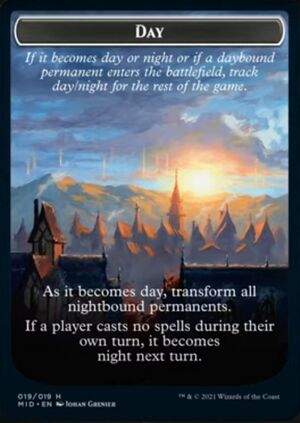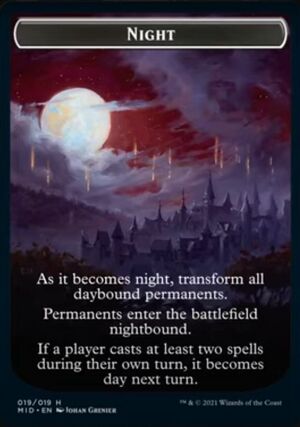Day and night
- For other uses, see Day counter.
Day and night are designations that a game of Magic: The Gathering can have, which changes the behavior or even the identity of certain cards, particularly those with daybound and nightbound. Either day or night is first applied to a game when a relevant card is played, and subsequently the two designations alternate back and forth based on the number of spells cast each turn, or by specific effects. Day and night were introduced in Innistrad: Midnight Hunt, as a refinement of mechanics which first appeared in Innistrad.[1][2]
Description
When the game starts, it's neither day nor night. In most games in which the mechanic is used at all, it will become day first. The most common way that will happen is if a permanent with daybound appears on the battlefield, and all other cards that care about day or night are permanents that start it on day. It may become night first through the effect of one of two sorceries (Unnatural Moonrise and Into the Night).
Once the day/night cycle begins, the game rules check each untap step for a condition to be met, which will automatically cause day to turn to night or back again:
- If it's day as a turn begins, and the previous turn's active player didn't cast a spell last turn, it becomes night.
- If it's night as a turn begins, and the previous turn's active player cast two or more spells last turn, it becomes day.
These apply to the entire game, not just one player at a time or each player separately. It can also switch one way or the other due to specific abilities. Once it's day or night, the game will be exactly one of those designations, day or night, going back and forth until the game ends, and can never return to being neither.
While any card can care about day or night, daybound and nightbound double-faced cards are the most closely connected to the cycle. If it's day, each will enter the battlefield with its daybound face up. If it's night, each will enter with its nightbound face up. As it becomes day, all double-faced cards with nightbound transform to their daybound faces, and vice versa. In other words, these double-faced cards are always in sync, no matter who controls them.
Several cards have triggered abilities which trigger when day becomes night or night becomes day. Since this event usually happens during the untap step when no players get priority, in those cases the abilities go on the stack at the beginning of the upkeep step.
These conditions are close to the triggered abilities of Werewolf double-faced cards printed in Innistrad block and Shadows over Innistrad block. The biggest difference is that only spells cast by the active player in the previous turn count for the condition, rather than spells cast by all players. A smaller one is that this change and corresponding transformations happen during the untap step all at once, whereas the earlier abilities are triggered separately during upkeep.
Day and night have fallen significantly on the Storm scale, having dropped from 5 to 9.[3] The fact that the effects have to be tracked regardless of the permanents remaining on the battlefield made it overly finnicky, especially at higher rules enforcement level. After the rotation from Standard, players would avoid using Daybound cards simply to avoid dealing with the logistics of the mechanic.
Helper card
To help keep track of day and night, some Innistrad: Midnight Hunt products provided a two-sided helper card that reminds players of these rules.
Rules
From the glossary of the Comprehensive Rules (November 14, 2025—Avatar: The Last Airbender)
- Day
- Along with night, a designation the game can have. See rule 730, “Day and Night,” and rule 702.145, “Daybound and Nightbound.”
From the glossary of the Comprehensive Rules (November 14, 2025—Avatar: The Last Airbender)
- Night
- Along with day, a designation the game can have. See rule 730, “Day and Night,” and rule 702.145, “Daybound and Nightbound.”
From the Comprehensive Rules (November 14, 2025—Avatar: The Last Airbender)
- 730. Day and Night
- 730.1. Day and night are designations that the game itself can have. The game starts with neither designation. “It becomes day” and “it becomes night” refer to the game gaining the day or night designation. It can become day or night through the daybound and nightbound keyword abilities (see rule 702.145). Other effects can also make it day or night. Once it has become day or night, the game will have exactly one of those designations from that point forward.
- 730.1a The phrases “day becomes night” and “night becomes day” refer to the game losing the first designation and gaining the second one.
- 730.2. As the second part of the untap step, the game checks the previous turn to see if the game’s day/night designation should change. See rule 502, “Untap Step.”
- 730.2a If it’s day and the previous turn’s active player didn’t cast any spells during that turn, it becomes night. Multiplayer games using the shared team turns option (see rule 805) use a modified rule: if it’s day and no player from the previous turn’s active team cast a spell during that turn, it becomes night.
- 730.2b If it’s night, and previous turn’s active player cast two or more spells during the previous turn, it becomes day. Multiplayer games using the shared team turns option (see rule 805) use a modified rule: if it’s night and any player from the previous turn’s active team cast two or more spells during that turn, it becomes day.
- 730.2c If it’s neither day nor night, this check doesn’t happen and it remains neither.
- 730.1. Day and night are designations that the game itself can have. The game starts with neither designation. “It becomes day” and “it becomes night” refer to the game gaining the day or night designation. It can become day or night through the daybound and nightbound keyword abilities (see rule 702.145). Other effects can also make it day or night. Once it has become day or night, the game will have exactly one of those designations from that point forward.
From the Tournament Rules (May 13, 2024—Outlaws of Thunder Junction)
- 4.9 Day/Night
Day/Night is a state that can change over the course of the game, but is not controlled by either player. Once created, it continues to be tracked, even if there are no objects in the game that care about the current state. It is the responsibility of both players to track the current state and point out when it is represented incorrectly by the shared method being used to track it.
Because responsibility for the state is shared, an erroneously-represented state should be handled as a Communication Policy Violation, but neither player receives the Warning. If the players and judges are unable to determine the current status, the judge should assume it is Night, as a turn with no spells played is more likely to be forgotten than a turn with multiple spells played.
Rulings
- If either the Day or Night designation is destroyed with Naturalize 2 (Mystery Booster 2), those designations are removed from the game. It will be neither day nor night until a player controls a permanent with daybound or nightbound, or a spell or ability says "it becomes day" or "it becomes night."[4]
References
- ↑ Matt Tabak (September 2, 2021). "Innistrad: Midnight Hunt Mechanics". magicthegathering.com. Wizards of the Coast. Archived from the original on 2021-09-02.
- ↑ Daybound & Nightbound. First Look: Innistrad: Midnight Hunt (Video). Magic: The Gathering. YouTube (September 2, 2021).
- ↑ Mark Rosewater (2025-04-25). "What's the current storm scale for daybound?". Blogatog. Tumblr.
- ↑ Eric Levine (September 20, 2024). "Mystery Booster 2 Release Notes". magicthegathering.com. Wizards of the Coast.

